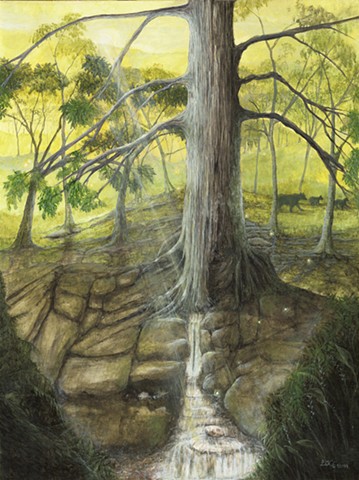Art Work
“Grandmother Tree”, 18x24, acrylic, © 9/2019, Lelia Canter.
“Grandmother Tree” was inspired by the artist’s love of forests and the natural environment and in part by research findings exploring
how trees in forests interact with each other.
According to research, fungal roots called Mycorrhiza produce a network of fungal threads forming a mycelium underneath the forest floor
that colonize the roots of all trees and plants. This mycelium connects trees of the same and different species within the forest.
Tree root cells and mycelium interact to form a network of fungal threads and nodes that communicate with one another to transfer carbon,
nutrients, water, defense signals and vital information back and forth between trees within the forest. Fungal threads serve as superhighways
for nutrients and information along the network and connect to large nodes or “hub trees” known as mother trees. These large nodes
(mother trees) are connected to their seedlings as well as hundreds of other trees in the forest. (1)
Similarly, the human and animal body is supported by connective tissue containing a ”supermolecular webwork” or living extracellular matrix
that extends into every nook and cranny of the body. In essence, when you touch a tree, human, or animal body, you are touching
intimately connected systems in which all the molecules are virtually linked together. (2)
Not unlike human parents, mother trees are known to reduce their own root systems to make room for their seedlings. When injured,
mother trees send carbon and defense signals through the Mycorrhizal Network that increase their seedlings resistance to future stresses
thus increasing resiliency of the whole tree community. Because of this network of accommodation and information, forests have
an enormous capacity to self-heal when given a chance. (1)
Because old growth forests are repositories of mother trees and their mycorrhizal networks; it is imperative to preserve these legacies
so they can pass their “mother tree” wisdom and genes onto the next generation of trees in order to withstand the stresses of the future. (1)
(1) Information obtained from a 2012 Ted Talks Summit titled “How Trees Talk to Each other” by Suzanne Simard,
Professor of Forest Ecology, University of British Columbia.
You can listen to the complete presentation at www.ted.com
(2) Information obtained from an excerpt by Dr.James Orchman from “Anatomy Trains” by Dr. Thomas W. Myers,
2009 Elsevier Limited.
Limited Edition Prints Available of This Image
Contact lelia@leliacanter.com for pricing and order information
Limited Edition Prints and Greeting Cards Available.
